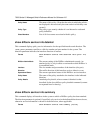
7000 Series L3 Managed Switch Reference Manual for Software v2.0
CLI Commands: Differentiated Services 9-27
Restrictions This shaping rate must not exceed the maximum link data rate of
the interface to which the policy is applied.
Policy Type Out
config diffserv policy shape peak
This command is used to establish peak rate traffic shaping for the specified class, which allows
transmissions for the class to exceed the committed information rate by sending excess traffic with
the understanding that it could be dropped by a downstream network element. The
<policyname>
and <classname> are the names of an existing DiffServ policy and class, respectively. Two rate
parameters are used, a committed information rate and a peak information rate. Each of these rates
is specified in kilobits-per-second (Kbps) and is an integer from 1 to 4294967295. The peak rate
must be specified as equal to or greater than the committed rate.
Note: Queue depth management defaults to tail drop, but the config diffserv policy randomdrop
command can be used to change to a RED scheme.
Format config diffserv policy shape peak <policyname> <class-
name> <1-4294967295> <1-4294967295>
Restrictions
Neither of the shaping rate parameters is allowed to exceed the
maximum link data rate of the interface to which the policy is
applied.
Policy Type Out
Incompatibilities Expedite (all forms)
Service Commands
The 'service' command set is used in DiffServ to define:
Traffic Conditioning Assign a DiffServ traffic conditioning policy (as specified by the
policy commands) to an interface in the incoming direction
Service Provisioning Assign a DiffServ service provisioning policy (as specified by the
policy commands) to an interface in the outgoing direction
The service commands attach a defined policy to a directional interface. Only one policy may be
assigned at any one time to an interface in a particular direction. The policy type (in, out) must
match the interface direction to which it is attached.


















